
Mary was a 1st century Galilean Jewish woman of Nazareth, the wife of Joseph and, according to the gospels, the virgin mother of Jesus.

According to apocryphal Christian and Islamic tradition, Saint Anne was the mother of Mary and the maternal grandmother of Jesus. Mary's mother is not named in the canonical gospels. In writing, Anne's name and that of her husband Joachim come only from New Testament apocrypha, of which the Gospel of James seems to be the earliest that mentions them. The mother of Mary is mentioned but not named in the Quran.

Saints Faith, Hope and Charity, are a group of Christian martyred saints, venerated together with their mother, Sophia ("Wisdom").

Church of the Sepulchre of Saint Mary, also Tomb of the Virgin Mary, is a Christian tomb in the Kidron Valley – at the foot of Mount of Olives, in Jerusalem – believed by Eastern Christians to be the burial place of Mary, the mother of Jesus. The Status Quo, a 250-year old understanding between religious communities, applies to the site.

The Wessobrunn Prayer is among the earliest known poetic works in Old High German, believed to date from the end of the 8th century.
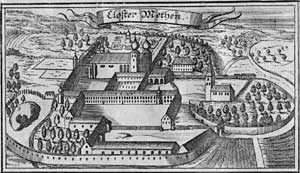
Metten Abbey, or St. Michael's Abbey at Metten is a house of the Benedictine Order in Metten near Deggendorf, situated between the fringes of the Bavarian Forest and the valley of the Danube, in Bavaria in Germany.

Saint Emmeram's Abbey, now known as Schloss Thurn und Taxis, Schloss St. Emmeram or St. Emmeram's Basilica, was a Benedictine monastery founded in about 739 at Regensburg in Bavaria at the grave of the itinerant Frankish bishop Saint Emmeram.

Wessobrunn Abbey was a Benedictine monastery near Weilheim in Bavaria, Germany.

Saint Ulrich of Zell, also known as Wulderic, sometimes of Cluny or of Regensburg, was a Cluniac reformer of Germany, abbot, founder and saint.
Diemoth was a recluse at Wessobrunn Abbey in Upper Bavaria, Germany, born around 1060 and died on 30 March, probably in 1130. She worked on 45 manuscripts from 1075 to 1130. Her name comes from the Middle High German word for "humility" or "modesty")
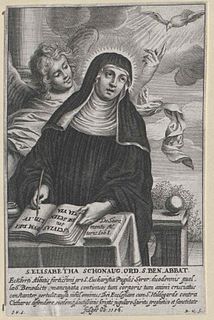
Elisabeth of Schönau was a German Benedictine visionary. She was an abbess at the Schönau Abbey in the Duchy of Nassau, and experienced numerous religious visions, for which she became widely sought after by many powerful men as far away as France and England.

Johann Baptist Zimmermann was a German painter and a prime stucco plasterer during the Baroque.

Saint Maurice was an Egyptian military leader who headed the legendary Theban Legion of Rome in the 3rd century, and is one of the favorite and most widely venerated saints of that martyred group. He is the patron saint of several professions, locales, and kingdoms.

Arilda, or Arild, was an obscure female saint from Oldbury-on-Severn in the English county of Gloucestershire. She probably lived in the 5th- or 6th-century and may have been of either Anglo-Saxon or Welsh origin.
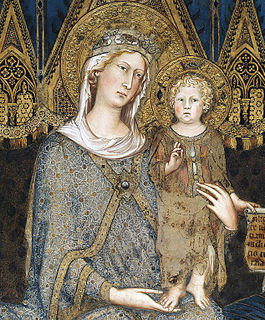
In the Catholic Church, the veneration of Mary, mother of Jesus, encompasses various Marian devotions which include prayer, pious acts, visual arts, poetry, and music devoted to the Blessed Virgin Mary. Popes have encouraged it, while also taking steps to reform some manifestations of it. The Holy See has insisted on the importance of distinguishing "true from false devotion, and authentic doctrine from its deformations by excess or defect". There are significantly more titles, feasts, and venerative Marian practices among Roman Catholics than in other Western Christian traditions. The term hyperdulia indicates the special veneration due to Mary, greater than the ordinary dulia for other saints, but utterly unlike the latria due only to God.

A miracle of the roses is a miracle in which roses manifest an activity of God or of a saint. Such a miracle is presented in various hagiographies and legends in different forms, and it occurs in connection with diverse individuals such as Saints Elizabeth of Hungary (1207–1231), Elizabeth of Portugal (1271–1336), St. Dorothy, a 4th-century virgin martyr at Caesarea in Cappadocia, and Our Lady of Guadalupe.
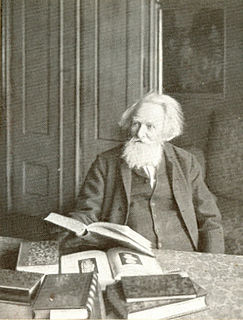
Johann Nepomuk Sepp was a German historian and politician, and a native of Bavaria.
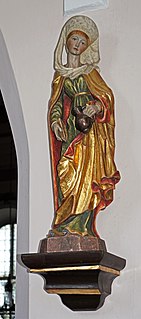
Saint Verena is an early Christian saint and hermit associated with the Theban Legion.

Johann Matthäus Meyfart, also Johann Matthaeus Meyfahrt, Mayfart was a German Lutheran theologist, educator, academic teacher, hymn writer and minister. He was an opponent fighter of witch trials.

Ida of Toggenburg is a Swiss Christian nun, venerated as a saint in the Diocese of Constance especially in Fischingen, Switzerland. She is the protagonist of many stories and legends in the local culture.



















